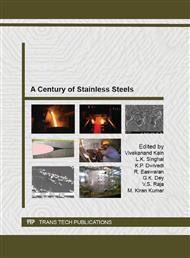p.626
p.632
p.645
p.670
p.681
p.691
p.697
p.705
p.714
Degradation/Damage Modes and their Control Measures for Stainless Steel Components in Chemical Plants
Abstract:
Safe and continuous operation of chemical plants is the most important issue for sustainability of chemical enterprises. The control and prevention of degradation/damage on components used in chemical plants are indispensable for this purpose. Although varied types of material, such as stainless steels, Ni-based alloys and reactive metals, are in use to control these phenomena in plants, various cases of degradation/damage have actually been experienced and the accidents caused by such degradation have occasionally been reported. In order to prevent such uncontrolled degradation, it is thought necessary to predict the likelihood of degradation of materials under actual operating conditions, to use compatible materials, to detect the degradation by inspection in advance and to apply proper countermeasures based on realistic life estimation of the plant concerned. In order to follow these processes properly, extensive accumulation and orderly organization of knowledge about the mechanisms on degradation/damages, characteristics of materials, inspection technics and methods of plant life estimation are thought of vital importance. As stainless steel is the commonly used material in chemical plants, sufficient accumulation of informattion and knowledge about the stainless steel components to be used is considered the most important subject to prevent the degradation/damage in chemical plants. This paper enumerates the characteristics of commonly encountered modes of degradation with stainless steel components in chemical plants and presents some cases of the degradation/damage on stainless steel equipment in plants, together with control measures required to prevent such degradation. The present-day problems of materials engineering relating to the reliability of chemical plants and the countermeasures against degradation/damage are also presented.
Info:
Periodical:
Pages:
681-690
Citation:
Online since:
September 2013
Authors:
Keywords:
Price:
Сopyright:
© 2013 Trans Tech Publications Ltd. All Rights Reserved
Share:
Citation:


